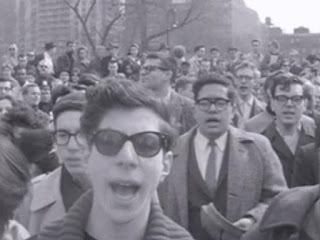 |
| "May The Fourth Be With You" walkasoff.com |
This past Thursday was a special day, at least, on the internet. It was May the Fourth and if you are a Star Wars fan like yours truly, you celebrated your inner Jedi However, Star Wars was not the only reason to celebrate like Wookie. May the Fourth was the 100th birthday of the godmother of modern planning-Jane Jacobs. Her iconic book The Death and Life of Great American Cities (1961; http://www.amazon.com) remains required reading for planners and preservationists. The book was published the height of the urban renewal movement. Death and Life was a complete contradiction to mainstream urban planners's misplaced faith in the glories of the "modern" city. Roberta Brandes Gratz marked the occasion for recent CityLab article, "The Jane Jacobs Century," to look back at just how and why Ms. Jacobs's insights still resonate today.
 |
| Jane Jacobs quotes azquotes.com |
 |
| Gaslight Cafe Greenwich Village, New York City, New York gvshp.org |
The Death and Life of Great American Cities and the six books that followed it were Ms. Jacobs's observations on what worked and what did not. One thing she did acknowledge was "a parallel to the ecology of cities in complex ecology of nature." She observed that parks designed as landscapes, instead for actual use, were empty. Further, she also paid attention to shopping streets with a variety of businesses drew the customers retail requires to do well.
In the preface to Death and Life, Ms. Jacobs writes,
The scenes that illustrate this are all about us. For illustrations, please look closely at real cities
 |
| Scene from the Beatnik Riot, April 1961 Greenwich Village, New York City, New York gvshp.org |
Consider the resurgence in popularity of historic neighborhoods-no just the ones designated historic districts. Empirical data suggests that these places most often have the highest property values. Start-up companies choose lofts and commercial neighborhoods for their businesses's headquarters, gradually reviving production-centered urban economies. Millennial residents have embraced bicycle and mass-transit as an option to the automobile.
 |
| White Horse Tavern Greenwich Village, New York City, New York gvshp.org |
However, the mistake would be to assume that all cities have regained their strength or recovered from decline. Just the opposite, American cities have been contracting since the post-war love affair with the suburb. The silver lining is, where smart policies have been implemented, where growing decline is recognized and appropriately mitigated, urban regeneration slowly takes hold and expands. Again, Jane Jacobs is sipping her cocktail, thinking "I told you so."
 |
| 1950 S. East East Harlem East Harlem, New York, New New York pinterest.com |
Nobody cared what we wanted when they built this place. They threw our houses down and pushed us here and pushed our friends somewhere else. We don't have a place around here to get a cup of coffee or a newspaper even...But the big men come and look at that grass, 'Isn't it wonderful! Now the poor have everything.
In her own way. Jane Jacobs celebrated the multiplicity of uses now seen in reviving cities; however she separated it from the congestions that accompanies excessive single-use development.
 |
| Washington Square Fountain Greenwich Village, New York, New York greenwichvillagehistory.wordpress.com |
...steady but gradual change...retains staying power after its novelty has gone...requires a myriad of gradual, constant, close-grained changes...
That close-grain element is precisely what is missing in the mad rush encouragement of more and more tourists.
The negative impact of accelerated change is barely acknowledged-especially in the mega-popular destinations of New York, New Orleans, and San Francisco. Ms. Brandes Gratz points out, "These cities ignore the wisdom of Jacobs at their peril. Not today or tomorrow, maybe not for years to come, their downfall is inevitable and it will be painful, unless they wake up to the urban dynamics that Jacobs chronicled and analyzed half century ago.
One thing is certain, if you heed the words of Jane Jacobs for the local, the tourist will follow; fi do it for the tourist, you lose the local and, eventually the tourist because it is the existing fabric that gives a place character. Read Jane Jacobs.
No comments:
Post a Comment